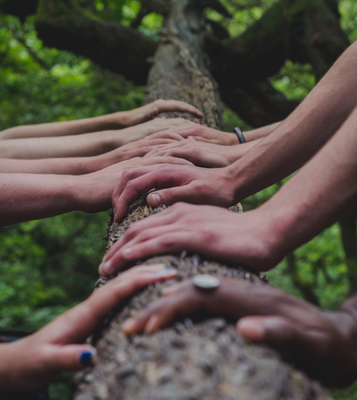2020 dragged us as a society through unprecedented health emergencies and a racial awakening following George Floyd’s murder that rippled across boarders. Companies and organizations jumped on DEI bandwagons faster than we could post a black square on social media, and the burden of carrying the optics of these organizations fell largely on marginalized employees. Not only did executives and leaders need to learn about health safety protocols and PPE, shifting entire operations online and welcoming the era of videoconferencing local staff, they also had to face the very public call outs of systemic racism and oppression permeating all aspects of society. More than ever before, power was given to diverse voices to help companies survive.
However, once survival mode has passed and we enter a new normal, we need to make sure that the power, agency, and space given to our staff and teams to keep us afloat are studied and real adjustments are made to support them long term if we want the company to thrive. We may never be able to get back to how things were – and frankly we should not strive to – but in order for us to move forward and create a workspace that is ready to welcome back employees and teams, this is the time to turn the intentions of DEI we have been setting into measurable actions across our organizations.
Actively addressing our inner biases when it comes to allocating space for people to share their current realities
Everyone is biased — that is not the issue. Our biases are informed by our personal lived experiences, the influences of our environment, our schooling and where and with whom we socialize. If we think about it, biases and lived experiences serve to protect us from learned threats and unfamiliar situations.
Living in a world completely devoid of bias is simply unrealistic; we can’t eliminate it from our workplaces. However, how we decide to let our biases guide our behaviors, especially those that are aimed at hindering, silencing or harming others, truly impacts the culture we create in our workplace and beyond.
A Caravanserai Project Monthly Webinar
A New Entrepreneurship Model:
Building A Workplace For The Future
Friday, October 28th, 2022
What do unchecked internal biases look like? What’s the cost?
In a company where more than ¾ of the C-Suite, of the board, or those who hold real power and influence all look the same, speak the same language, have the same educational background, frequent the same social circles, leaders mirror each other’s thought processes and approaches to all aspects of the company’s health. We have a tendency to feel safer, stronger and fairer when we are surrounded by people who look like us and see the world through the same or similar lens. We are not challenged to think differently, therefore we believe our initial way of thinking must be the right one. We choose peers who resemble us. We reinforce our tunnel vision of what is happening and how things should be.
When we are presented with people who bring ideas that seem far from our habitual approach, we hesitate to let them in. If we continuously overlook these moments of hesitation, of snap decisions that systematically favor those who resemble us over those who don’t, we are keeping our organizations from benefiting from the talents and unique perspectives that “outsiders” bring to the table. It costs us the solutions that help us overcome obstacles we are currently facing, and crises we have yet to identify.
Where can we start?
Erika James, Ph.D., shares the leadership lesson on Brené Brown’s Dare to Lead podcast: manage your energy first before managing it in others. As leaders trying to integrate DEI practices into our everyday lives, recognizing our behaviors and patterns is essential to correcting them. We cannot afford to remain ignorant while there are so many resources available to aid in our education. Learning about harmful leadership behaviors is the cornerstone of dismantling toxic patterns. Ask yourself: What was “off” about the way this situation was handled? What made me uncomfortable when my view or idea was challenged? What stopped me from considering another perspective? What would my decision or action have been had the perspective been closer to my own?
Although our reflexes can be to over-correct our past behaviors, starting by talking to the people affected by our biases is the first step. Ask your staff, and your peers, to hold you accountable and embrace talking through your hesitations and assumptions. Leaning into being a learner, acquiring information about people, about relationships you hold with your staff and teams, and using that information to question your own actions will truly help you check your biases before you act on them.
Managing our expectations on how our employees and team members will show up in spaces we’re creating within the organization
When was the last time we heard someone tell us to bring our whole selves to our jobs? Only to be hit with a wave of uncertainty of what it means. When we don’t invest the time to cultivate trust, build support frameworks for our teams when they do show up as their authentic selves, we are setting ourselves up for a lot of trouble.
What is psychological safety in the workplace and how to ensure it?
Psychological safety is crucial in a work space, especially if we want our teams to trust us and each other. This is especially true when speaking about marginalized employees. The stage needs to be set to ensure everyone feels comfortable sharing concerns, asking naïve questions, challenging existing processes and methods, and making mistakes. Our teams need to know that being perfect, and agreeing on everything with the leader is not what we’re asking of them.
Building this safe space at work is important to consider when we ask our peers to “bring their authentic selves” to a discussion – whether it be a brainstorm, a performance appraisal, or a negotiation. If we can’t properly handle conflicting ideas and perspectives, we really have no business asking people to share openly. The folks over at Center for Creative Leadership share the following 5 ways a leader can promote psychological safety in the workplace :
- Make psychological safety an explicit priority;
- Facilitate everyone speaking up;
- Establish norms for how failure (or conflict) is handled – and apply it equitably;
- Create space for new ideas (even wild ones);
- Embrace productive conflict.
Read more about their approach for these steps here.
When the fear of failure, ridicule or dismissal is eliminated, true conversation and engagement is brought forth. The joy of fearlessly creating, exploring and daring will only benefit the company culture, build better leadership, and result in some innovative and unexpected product ideas. As a leader, consistently working to create a space where failure is not the end of the road but a welcomed and understood part of the journey – even when the journey is challenging – we are showing our employees, our peers, that their place and value are not solely contingent on perfection and compliance.
Collecting data on how our employees have experienced the changes rolled out during the pandemic and what their needs are moving forward
The past few years have been a sort of awakening for leaders regarding management practices and for others, they have been a reinforcement of what they already knew : flexibility is pivotal in most knowledge work. None of us are the same as we were in the early days of the pandemic when we thought we were going to just take a 2-week work-from-home break and be back in our offices. Working parents became teachers. Many of us became care providers for our aging parents. These realities humbled us quickly and our 9 to 5 work days went out the window. On the other hand, some of us thrived working from home, where we could actually practice more realistic boundaries and plan our work days based on our needs (eat, sleep, play).
What can we do to ensure that our teams know we are listening and are ready to support them?
In order to properly evaluate the wellbeing and happiness of our employees, we need to define metrics that actually measure their newly developed needs. A recent Deloitte article outlines the significance of companies being honest and transparent about where they are in terms of employee wellbeing and what they are ready to work on to achieve better retention. By now we have all heard of the “Great Resignation”, millions of employees quitting their jobs per month over the last year. The report cites that “56% of employees aged 18–24 say they would quit a job that prevented them from enjoying their lives; 38% of those 55–67 agreed.” What does that mean when it comes to how we evaluate wellbeing? Long gone are the days of routine and repetitive company-wide surveys asking employees if they are satisfied with how things are going and expecting the data to paint a realistic picture of how everyone is feeling. We need to break down what our holistic approach to measuring well being (mental, physical, psychological and financial) and satisfaction actually is.
Workload, work hours, and salary are all basic metrics. What needs to be brought forward in today’s surveys is how our organization’s mission, vision, values and behaviors speak to our employees’ core values. The inclusion of multiple perspectives needs to be included when building a 360° evaluation of the organization’s performance. How are our employees identifying with the work that they are doing in our organization? How many of them have access to benefits that take into account their personal situations and can accommodate for changes like health issues, loss of a relative, or going back to school? Will we be studying the benefits of a hybrid model and take the load off of peers who spend a significant time of their days traveling to and from the office? As leaders, we are meant to look for more than what only affects us. We need to keep our eyes open to what is happening in the world and how that affects our teams in order to see how our organization can respond and show up for them.
Thinking long term
Sustainable and inclusive workplace cultures require commitment from everyone. That being said, it’s the steps that us leaders can take to ensure that our teams, and ourselves, are equipped to navigate our professional and personal lives in a safe and healthy manner that truly make the difference. This is our time to prove that the changes we so desperately needed to make when we realized that traditional models of business and management were not going to survive a pandemic (pivoting to working from home, video conferencing, engaging more on social media, adopting a work from anywhere policy, expanding health insurances) were not made solely because it was the right call for the bottom line at the time. The changes that benefited and spoke to the humans working for us and with us are worthy long term investments.

Taharima Habib is a multidisciplinary community builder and organiser, specializing in facilitation and training design for nonprofit and charity organisations. Born in Bangladesh, she came to Canada at the age of 3 with her family and calls Montreal her home.
Taharima has a Masters degree in Microbiology and Infectiology from the University of Sherbrooke, where she studied the functions of HIV. After falling in love with the communications and public facing aspect of her academic work, she left research to pursue a career in the community and nonprofit sector across Montreal, in grassroots and national organisations. Her focus has always been on identifying who the underdogs were in each system she interacted with, and assessing what was keeping them from accessing the resources and services for thriving instead of merely surviving.
Today, Taharima is working with junior and senior staff members in mission-driven organisations across Canada, helping them with professional development, and with board directors as a consultant in Culture and Capacity Building. Taharima joined Caravanserai Project as an Associate in 2022.







